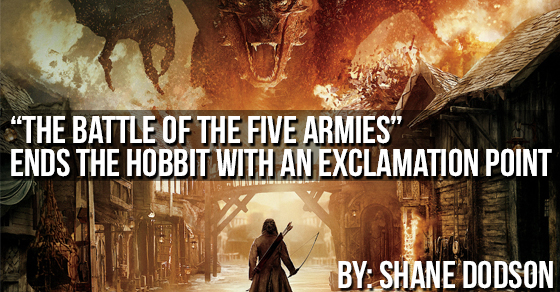Peter Jackson so placed his indelible artistic stamp on his Lord of the Rings trilogy that when he decided to film the first Middle-Earth book, The Hobbit, comparisons were inevitable. The books themselves don’t invite such comparisons; J.R.R. Tolkien wrote The Hobbit before The Lord of the Rings. However, in Movie-Land, prequels are the new sequels, and Jackson so fell in love with the cinematic Middle Earth he helped to create that’after the cinematic triumph of Return of the King‘he decided to proceed to the beginning. The result is his Hobbit film trilogy, which began with An Unexpected Journey, then on to The Desolation of Smaug, and now we have the finale, appropriately titled The Battle of the Five Armies (originally, Jackson was going to go with the title There And Back Again but, given that about half the film is non-stop battle and carnage, Battle of the Five Armies offers a much more accurate description of the movie).
As a third part in a trilogy goes, Five Armies is surprisingly successful. Things got off to a slow and sluggish start with An Unexpected Journey, in which Jackson unfortunately decided to remain faithful to the book’s slow beginnings. The story’and the pace’picked up quite considerably in Desolation, although I was put-off by that film’s waaaaaaaaay overcooked climax featuring the Dwarves’ attempts to kill the villainous dragon Smaug (voiced with passionate hatred by Benedict Cumberbatch). The cliffhanging ending, though, was perfect, and Five Armies picks right up where we left off. Smaug is flying toward the helpless Lake-town with plans to burn it to the ground.
For those not familiar with the source material on which The Hobbit movies are based’sometimes faithfully, sometimes very very loosely’I won’t give much else away. Suffice to say if you haven’t seen either of the first two Hobbit films you’re likely to be completely lost here. With the Dwarves’ formerly-lost kingdom now reclaimed by Thorin (Richard Armitage), his small company of dwarfs and a single Hobbit, Bilbo Baggins (Martin Freeman), armies of men and elves show up at front door in the hopes that Thorin will honor agreements he made earlier in the story. However, Thorin has been seized and overtaken with greed and paranoia, so he angrily turns them away. But man and elf won’t take no’ for an answer, so armies amass in the field outside of the Dwarf kingdom and prepare for war. Little do they know that three different armies are about to converge on the battlefield, the outcome of such a skirmish will forever change the future of Middle-Earth.
The sparse plot was stretched out entirely too thin in the first Hobbit film and’while the second film was an improvement in pacing’it was still too meandering in parts. The third film jumps out of the gate from the first few minutes and doesn’t let up until the last orc has been skewered. Jackson has a firm and confident grasp on the material here, and he puts all of his skills as a filmmaker on display. Sometimes, he goes for minimalism (that simple shot of Thorin lusting over his gold-filled kingdom). Other times, he goes for all-out show-stopper (those swooping shots of four different armies advancing on each other). With all of the swordplay, flying arrows, and CG beasties on display, Jackson never loses sight of his characters. While most of the thirteen dwarves get short-thrifted (they did in the book, too), Thorin’s tragic character arc and Bilbo’s stalwart loyalty to his newfound friends are always front-and-center. The battle of the title encompasses over half of the movie and carries with it an enormous body count, some of them major characters. Emotions run high and lives are forever changed. As with Return of the King, Jackson saves the best for last.
There are also themes that resonate strongly in this third chapter. While the enslaving power of the One Ring isn’t an issue here, the all-encompassing power of greed is portrayed vividly, as are the consequences of breaking one’s word. Some of the most dramatically potent material here cannot be found anywhere in the pages of Tolkien’s book: a budding romantic relationship between a heroic dwarf and a lovely Elf warrior, and the big reveal of the evil Sauron, from whom Gandalf is rescued by returning Middle-earth alums Lady Galadriel (Cate Blanchett), Elrond (Hugo Weaving) and the wizard Sarumon (Christopher Lee). The latter sequence appeared elswhere in Tolkien’s literature and fans will most likely get a kick of seeing how well Jackson films it here.
Prequels are a funny thing. Before Peter Jackson made his Hobbit trilogy, George Lucas decided to tell various backstories in his Star Wars universe. The results made a ton of money but angered a lot of fans (not this particular Star Wars fan, though). Films that are as artistically assured as the original Star Wars and Lord of the Rings trilogy are impossible to top; they are bona fide classics. Fortunately, I never got the impression that’with his prequel trilogy’Lucas was trying to top what he accomplished in the original movies. Likewise, I don’t get the impression that Jackson is trying to improve upon his original Lord of the Rings trilogy. This is an unapologetically smaller story. He’s not trying to one-up his previous movies; instead, he’s trying to compliment them. There’s even a very neat coda here that ties this story directly into The Fellowship of the Ring. After getting off to a slow start, The Battle of the Five Armies ends Peter Jackson’s journey through Middle-Earth on just the right note.
Sacrifices are made.
Lives are lost.
Character is forged.
Good prevails.
- An Open Letter to Charlie Sheen - Nov 17, 2015
- “Jurassic World:” A Sequel That Knows It’s a Sequel - Jun 15, 2015
- “Tomorrowland:” Disney Goes Postmillennial - May 23, 2015

